What is Cement: Cement is a binding material in construction that is used for setting, hardening, and adhering to other materials to bind them together. Cement is mixed with fine aggregates to produce mortar, which is used for masonry, and with sand and gravel to produce concrete. The cement, which is used in construction, is inorganic and is generally composed of lime or calcium.
WHAT IS CEMENT MADE OF
CEMENT MANUFACTURING
CEMENT COMPOSITION
TYPES OF CEMENT
TOP CEMENT BRANDS IN INDIA
IS CEMENT AS STRONG AS CONCRETE
What is Cement made of
Cement is made up of a chemical combination of 8 main ingredients during the cement production process. These ingredients are generally extracted from limestone, clay, marl, shale, chalk, sand, bauxite, and iron ore.
Cement Manufacturing Process
Cement manufacturing is a complex process that starts with first mining and then grinding the raw materials. The raw materials are limestone and clay, which are ground to a fine powder, which is then heated at a high temperature of 1450 degrees Celsius in a cement kiln.
In the above process, chemical bonds between the raw materials are broken and then they are recombined to form new compounds. The new compound formed is called a clinker which are rounded nodules between 1mm and 25 mm.
The clinker is grounded to form fine powder in a cement mill and then is mixed with gypsum to produce cement. The powdered cement is then mixed with water and aggregates to form the concrete that is used in construction.
Cement Composition
- Lime or Calcium oxide(CaO): Sources are limestone, chalk, shells, shale, or calcareous rock
- Silica(SiO2): Sources are sand, old bottles, clay or argillaceous rock
- Alumina(Al2O3): Sources are bauxite, recycled aluminium, clay
- Iron(Fe2O3): Sources are clay, iron ore, scrap iron, and fly ash
- Gypsum(Ca2SO4.2H2O): found in limestone
Types of cement
1. Ordinary Portland Cement (OPC)
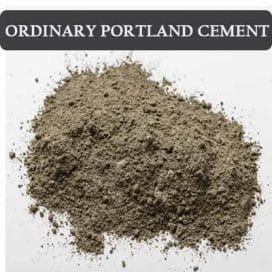
Ordinary Portland Cement is a hydraulic cement that consists of two-third of calcium silicates (3 CaO•SiO2, and 2 CaO•SiO2), the remaining components are aluminium and iron-containing clinker and other compounds. The ratio of CaO to SiO2 is greater than 2.0. The magnesium oxide content (MgO) is always less than 5.0%.
The composition of Ordinary Portland Cement is as follows:
- Argillaceous or silicates of alumina ( sources are clay and shale)
- Calcareous or calcium carbonate (sources are limestone, chalk, and marl)
Uses of Ordinary Portland Cement are as follows:
- It is mainly used for the purpose of general construction
- It is also generally used in masonry works and projects
2. Portland Pozzolana Cement (PPC)
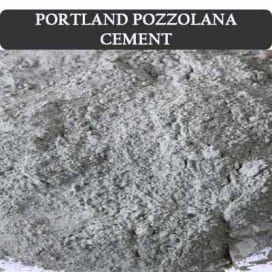
Portland Pozzolana Cement could be a naturally created artificial cement that contains oxide in reactive forms. It reacts with hydrated oxide to make further cementations materials once it’s finely divided.
The composition of Portland Pozzolana Cement is as follows:
- OPC clinker
- Gypsum
- Pozzolanic Materials (Sources area unit ash, volcanic ash, and Calcined clay or oxide fumes)
Uses of Portland Pozzolana Cement area unit as follows:
- PPC is typically utilized in hydraulic structures, marine structures, construction comes near shore, dam construction, etc
- It is additionally utilized in pre-stressed and post-tensioned concrete members
- As it provides a stronger surface finishing, it’s utilized in ornamental and art structures
- It is additionally utilized in the manufacture of formed sewerage pipes and art structures
- It is also used in the manufacture of precast sewage pipes
3. Rapid Hardening Cement
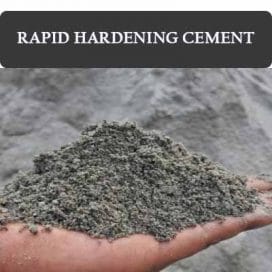
When finely grounded Tri-calcium salt (C3S) is added in OPC cement with higher content, it gains strength over OPC cement. This sort of OPC is named fast Hardening Cement. Its initial setting time is half-hour and final setting time is 600 minutes.
The composition of fast hardening cement:
• Tricalcium salt (C3S)
• Dicalcium salt (C2S)
• Tricalcium compound (C3A)
• Tetracalcium aluminoferrite of the whole weight of cement
Uses of fast Hardening Cement:
• Rapid hardening cement is generally used wherever fast construction is required just like the construction of pavements
• It is employed where high strength is needed
4. Quick Setting Cement
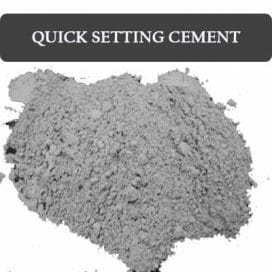
Quick setting cement is that the cement that sets in an exceedingly very short time. The initial setting time is five minutes and therefore the final setting time is half-hour.
The composition of Quick Setting Cement:
- Clinker
- Aluminium salt (1% to three by weight of clinker)
Uses of Quick Setting Cement:
• It is employed in underwater construction
• It is additionally employed in rainy & weather conditions
• It is employed at higher temperature wherever water evaporates simply
• Also used in anchoring or rock bolt mining and tunneling
5. Low Heat Content Cement
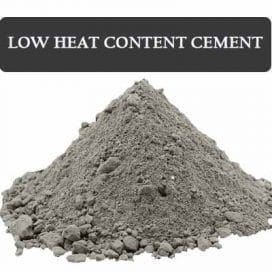
It is a special variety of cement that produces low heat of association throughout the set time. Some chemical composition of standard hydraulic cement is changed to cut back the warmth of association.
The chemical composition of low enthalpy cement:
• A low proportion (5%) of tricalcium chemical compound
• A higher proportion (46%) of declaiming salt
Uses of Low Heat Cement
• It is employed for the development of the dam’s massive footing, massive raft slabs, and turbine plinths
• It is additionally used for the development of chemical plants
Top Cement Brands In India
List of prime ten firms in Bharat by revenue and market share:
1. UltraTech Cement Ltd
UltraTech Cement Ltd. is the largest manufacturer of gray cement prepared to combine Concrete (RMC), and white cement in Bharat. Its conjointly one among the leading cement producers globally. Ultratech is the Largest among the highest five cement firms in Bharat.
• Revenue: Rs 38657 Cr
• Production capacity: 102.75 MTPA
• Employees: 12000
• Market Share: 21.4 %
2. Ambuja Cements Ltd
Ambuja Cements Ltd is among the highest ten Cement firms in Bharat. It’s the second-largest producer of cement in Bharat supported turnover.
• Revenue: Rs 26646 Cr
• Production capacity: 29.65 MTPA
• Employees: 5180
• Market Share: 6.2 %
3. ACC Ltd
ACC restricted is one of India’s leading makers of cement and premix concrete with seventeen cement factories, seventy-five prepared combine concrete plants. It’s the third leading cement firms in Bharat.
• Revenue: Rs 15398 Cr
• Production capacity: 28.4 MTPA
• Employees: 6731
• Market Share: 6 %
4. Shree Cement Ltd
Shree Cement Ltd is that the Fourth among the highest ten firms in Cement in terms of sales. These days Total Cement capability of the corporate is 29.30 million tons.
• Revenue: Rs 12,555 Cr
• Production capacity: 29.30 MTPA
• Employees: 6,299
• Market Share: 7%
5. Dalmia Asian Country Ltd
Dalmia Asian country Ltd is Fifth among the highest ten firms in Cement by Total Revenue. The corporate has cement producing plants within the southern states of the province (Dalmiapuram & Ariyalur) and province (Kadapa), with a capability of nine million tonnes once a year.
• Revenue: Rs 9,642 Cr
• Production capacity: 26.5 MTPA
• Employees: 5,634
• Market Share: 5.5 %
6. Birla Corporation restricted
Birla is the flagship Company of the M.P. Birla cluster. It’s one of the highest leading cement corporations in India.
• Revenue: Rs 6,778 Cr
• Production capacity: 15.5 MTPA
• Employees: 5,776
• Market Share: 3.2 %
7. India Cements Ltd
India cements Ltd was established in the year 1946 by 2 men, Shri S N N Sankaralinga Iyer and Sri T S Narayanaswami.
• Revenue: Rs 5,770 Cr
• Production capacity: 15 MTPA
• Employees: 4300
• Market Share: 3
8. The Ramco Cements restricted
Ramco Cements restricted is the company of the Ramco cluster, which is a well-known business cluster of South India. It has it’s headquarter in Chennai. It’s in the eighth position in the list of ten cement companies in India.
• Revenue: Rs 5,310 Cr
• Production capacity: 16 MTPA
• Employees: 3034
• Market Share: 3
9. Orient Cement Ltd
Orient Cement was once, a region of Orient Paper & Industries. It is emerging as one of the fastest-growing and leading cement makers in India.
• Revenue: Rs 2,570 Cr
• Production capacity: 8 MTPA
• Employees: 1500
• Market Share: 1.6 %
10. Heidelberg Cement India Ltd
Heidelberg Cement India restricted could be a subsidiary of Heidelberg Cement cluster, Germany. The corporate has its operations in Central India at Damoh (Madhya Pradesh), Jhansi (Uttar Pradesh), and in Southern India at Ammasandra (Karnataka).
• Revenue: Rs 2,182 Cr
• Production capacity: 5.4 MTPA
• Employees: 1100
• Market Share: one: 1 %
Is Cement as Strong as Concrete
Pure cement isn’t stronger than concrete as cement is just binding materials that bind mixture and sand with the assistance of water. If alone cement is employed it’ll shrink and has no compressive strength that concrete is thought for. Pure cement is truly an element of concrete.
Cement is truly a dry and achromatic powder that solidifies once water is added. It’s the ingredient that hardens concrete once water is mixed.
Concrete, on the opposite hand, is created of a minimum of 3 elements cement, sand, and aggregates. Cement may be thought of as the “glue” that binds these ingredients.
Concrete may be thought of as stronger since it contains gravel and aggregates that create a lot of hard-wearing. Concrete conjointly gets tougher with age. Cement may be a binder and concrete forms the majority.
The strength depends on the water/cement magnitude relation. The lower the magnitude relation, the higher is the strength and vice-versa. However lower water content makes it troublesome to compact the concrete particularly if it’s a ferro-concrete structure. To beat the problem we tend to use the large-sized mixture in mass concrete structures and lower size aggregates in ferro-concrete structures. For an identical volume of aggregates, a bigger particle size features a lesser expanse therefore a lesser amount of the water-cement paste is going to be adequate. Therefore there’s nothing like whether or not concrete or cement being the stronger of the two.
Summary
Cement could be a binding agent to stick various building materials along. The foremost common forms of cement employed in the development trade are Portland cement and Asphalt cement. Portland cement one of the foremost vital ingredients in concrete. It’s either in the form of dry powder or in the paste (mortar) that hardens and binds to all matter it’s touching. Cement could be a basic material for every type of construction together with housing, roads, schools, hospitals, dams, and ports, also for ornamental applications and things like tables, sculptures, or bookcases.

